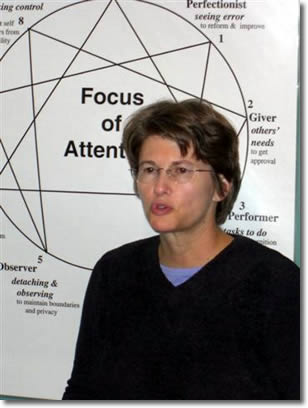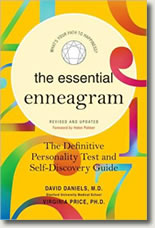Spirituality and Personality
A few basic concepts for understanding the Enneagram
 “What is your greatest obstacle to your deepest prayer?” This question posed by monks living in the Egyptian desert is as relevant today as it was in the fourth century. What blocks us from living out our deepest prayer is ourselves. Identifying how we block our own spiritual progress requires consistent self-observation, appropriate questions for self-reflection, and a supportive community.
“What is your greatest obstacle to your deepest prayer?” This question posed by monks living in the Egyptian desert is as relevant today as it was in the fourth century. What blocks us from living out our deepest prayer is ourselves. Identifying how we block our own spiritual progress requires consistent self-observation, appropriate questions for self-reflection, and a supportive community.
As we begin, “Who am I?” is an appropriate question for our spiritual work. Ego manifestations stand in the way of deepening our spiritual lives. Identity consciousness allows us to deepen our relationships because we are more fully ourselves. Becoming conscious of patterns that engender automatic responses and habits that limit our creativity gives us opportunities to wake up to ourselves and our lives.
Grappling with and understanding the patterns of our personality structure is crucial to our spiritual growth. So, how can we get a clear picture of the patterns of our personality that are stumbling blocks to deepening our spirituality?
In my years of companioning individuals and groups, I have found the Enneagram Personality System to be extraordinarily insightful in revealing mental and emotional habits of nine distinct personality types. No type is better or worse than another, and we remain the same personality type throughout our lives. Our journey is not to change our personality (it’s there for good reason!) but to soften it, so we can use its gifts to expand awareness, deepen our compassion and enrich our spiritual lives. In the grip of personality or ego, we remain in lockstep to its life-denying patterns that sing us to sleep. Enlightenment is waking up.
Virtues and Vices
The Enneagram (ennea is Greek for nine) is an ancient map of process and self-discovery that is experiencing a burst of popularity in our culture and quickly becoming recognized as an effective tool for personal, professional and spiritual growth. Interestingly, the Enneagram system has some of its roots in the Christian desert tradition.
The recent work of teacher and author Helen Palmer in the Origins of the Enneagram explores the life of Desert Father Evagarius of Pontus, who named the “seven deadly sins” (actually, he named eight) as obstacles to our deepest prayer. These eight are also eight of the nine vices, or emotional habits, named in the Enneagram system. The Enneagram adds fear to the list of anger, pride, self-deceit, envy, avarice, gluttony, lust and slothfulness. When our vices control us, we feel contracted and our focus of attention and perception of reality narrow.
On the other hand, when we are awake to our lives, it becomes possible to respond from our virtue, allowing us to see reality unobscured by our personality’s filter. The Enneagram offers the spiritual virtues of the nine types as serenity, humility, honesty, equanimity, non-attachment, courage, sobriety, innocence and right action. In moments of awe, when we are fully present , we find ourselves planted in our virtue. Experiences of our virtue are grace-filled moments. They are expansive and open our hearts to compassion.
Spiritual Transformation
Spiritual transformation can be understood as a conversion of energy: shifting the energy from the contracted posture of the vice of our Enneagram type to our virtue. It may sound simple, but in fact, hardwired responses are difficult to soften and shifting this energy requires a strong dose of desire along with considerable effort and self-observation. Repetition of new habits and patterns create new neural pathways that, over time, allow us to catch our automatic responses before they get going. Thus we have a choice in how we respond and can shift our behavior.
Centers of Intelligence
The Enneagram acknowledges three centers of intelligence: head, heart, and gut. In other words, we have three brains. (Isn’t that a relief!) In the “head center,” our mental faculties allow us to know through logic, reason, imagination, and analysis. Our “heart center” knows through mood, tone and feeling, while our “gut or body center” knowing is kinesthetic, working with instinct and physical sensation. We have all three ways of knowing but each of us leads with one of these centers.
Ideally, we want to access all three centers. It’s important not to segment the centers but have each in dynamic relationship with the other two. If we operate only from one center, we are asleep. When we are open to all three ways of knowing and there is a fluidity among these centers, our wisdom and intuition arise. Our lives are more balanced when these “three brains” are in harmony.
In a recent Enneagram workshop, a retired medical school professor shared this with the group: “When making rounds with interns, I instructed them to check in not only with their minds, but with the intelligence of the heart and body before making decisions about patients. No decision can be made until all three of these were in agreement. And, I didn’t even know the Enneagram at that time!”
